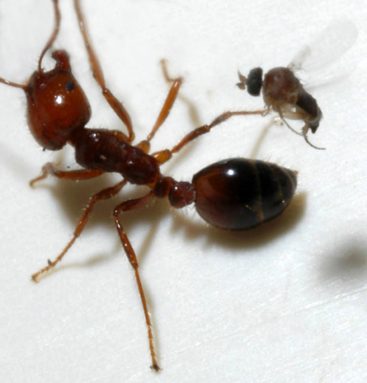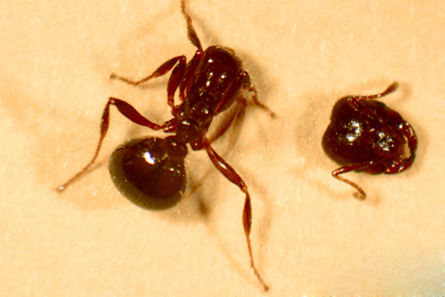The case of the headless ant
Flies find and decapitate fire ants by tracking their venom
Halloween is right around the corner, which means scary movies are playing at the theater and trick-or-treaters are shopping for costumes. This year, there’s no need to go looking for spooky thrills and chills in graveyards — inspiration can come from nature.
 |
|
Caption: A phorid fly hovers above a fire ant before laying an egg in the ant’s thorax. Fire ant venom attracts the flies to the ants, scientists report.
|
| S. Porter/USDA-ARS |
Consider the case of fire ants and phorid flies. Fire ants are venomous pests that roam the southeastern United States and pack a powerful punch with their bite. Phorid flies are tiny bugs, half the size of a grain of rice. When a phorid fly lands on a fire ant, it deposits eggs in the ant’s chest. An egg hatches, and the fly pupa makes its way to the ant’s head.
And cuts the ant’s head off.
Scientists have known for years that flies can decapitate ants, but they didn’t know how the flies were able to find the unlucky ants in the first place. According to a recent study, the flies track the ants by tracking chemicals from a surprising source: the ants’ venom. In other words, the fire ants’ own poison works against them.
The study was led by Henry Fadamiro, an entomologist at Auburn University in Alabama. An entomologist is a scientist who studies insects. Fire ants give off a wide range of different chemicals, and Fadamino and his team wanted to know which of these chemicals attracted the flies.
In their experiment, they attached small electrodes to the antennae of the flies and then exposed the flies’ antennae to different chemicals from fire ants. These electrical devices were able to detect signals from the nervous systems of the flies. As a result, they were able to determine which chemicals caused the flies to get excited.
 |
|
This decapitated fire ant was a victim of a tiny fly whose young eat the ants from the inside out, eventually beheading them.
|
| S. Porter/USDA-ARS |
The flies responded to chemicals from the venom of the fire ants. Fadamiro and his team then separated the venom into its different chemical components and tested those chemicals as well. They wanted to know which specific chemical compounds the flies liked best. The venom is mostly made up of alkaloids, which are chemical compounds that contain nitrogen and can be poisonous.
Fadamiro’s research may result in a new way to control the fire ant population in the United States. By understanding what makes phorid flies tick, scientists may be able to figure out how to attract them to areas—say, where fire ants thrive. If phorid flies can be introduced to these areas, they may help take the sting out of fire ant infestations.
“We hope if we get the right combination, that these … methods will begin to really make a difference,” says Sanford Porter, a fire ant specialist with the U.S. Department of Agriculture’s Agricultural Research Service in Gainesville, Fla.
Fadamiro’s research also explores how gruesome some animals can be. And even though this science is not just a Halloween curiosity, it may inspire a spooky holiday. For a scary costume this year, why not grab a friend and go as a naturally creepy duo: the headless fire ant and the phorid fly?
POWER WORDS
venom A poisonous secretion of an animal, such as a snake, spider, or scorpion, usually transmitted by a bite or sting
gland A cell, a group of cells, or an organ that produces a secretion for use elsewhere in the body or in a body cavity or for elimination from the body
chemical A substance with a distinct molecular composition that is produced by or used in a chemical process
electrode A solid electric conductor through which an electric current enters or leaves an electrolytic cell or other medium.
alkaloid Any of various organic compounds, normally with basic chemical properties and usually containing at least one nitrogen atom. Many alkaloids, such as nicotine, quinine, cocaine, and morphine, are known for their poisonous or medicinal attributes.
nitrogen A nonmetallic element that constitutes nearly four-fifths of the air by volume, occurring as a colorless, odorless, almost inert diatomic gas, N2, in various minerals and in all proteins and used in a wide variety of important manufactures, including ammonia, nitric acid, TNT, and fertilizers.
pupa The nonfeeding stage between the larva and adult in the metamorphosis of some insects
Going Deeper:







